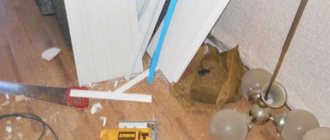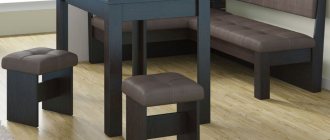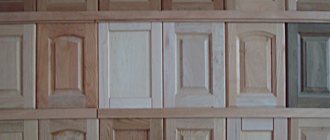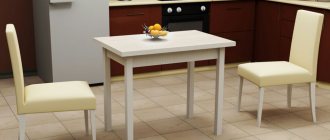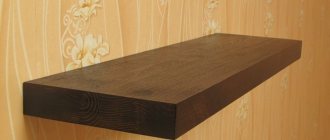0
24010
The kitchen is the place where masterpieces are born. In the midst of a culinary experiment, it is not always possible to notice how splashes of fat fly from the frying pan onto the walls, and streaks remain. And then the question arises of how to remove grease from kitchen furniture, especially since there are many means, including folk and household chemicals. In order not to make a mistake with your choice and not to harm the kitchen environment, you need to know the nuances of each of them.
Features of a wooden kitchen
Depending on the manufacturing technology and material, kitchen furniture may be sensitive to one or another type of cleaning.
When cleaning wooden kitchen furniture from grease, you need to be extremely careful.
In particular, wooden surfaces can be irreparably damaged:
- mechanical processing;
- exposure to acids and alkalis;
- plenty of water;
- excessive dryness;
- high temperatures.
Among other things, wood is a material with a porous structure. Therefore, if you do not wash your wooden kitchen regularly, over time the grease penetrates into its thickness and is difficult to remove.
We must not forget that fat deposits tend to polymerize. It is almost impossible to wash such stains without special professional products.
How to remove stains from upholstered furniture?
Cozy sofas or armchairs often become objects of play for small children or a favorite sleeping place for pets. Adults can also, due to their carelessness, stain upholstered furniture. Quite often, various contaminants appear on it, which darken over time and spoil the appearance of the upholstery. A particularly pressing question is how to remove grease stains from furniture. To remove them, use one of the following methods.
Method 1
If you see the contamination in time and it has not yet had time to be absorbed, proceed as follows:
- Apply a small amount of salt (preferably finely ground) to the stain.
- Rub gently with a soft sponge for 2-3 minutes.
- Change salt soaked in fat if necessary.
- Blot with a cloth soaked in a weak solution of medical alcohol.
- Let dry.
Important! If you don't have alcohol on hand, you can use regular wet wipes for your hands or furniture instead. They usually contain a certain amount of alcohol and disinfectant components.
Method 2
To remove fresh stains, use laundry soap:
- Take a clean cloth.
- Apply to the stain several times to absorb as much oil as possible.
- Grate the laundry soap.
- Dissolve it in warm water.
- Beat until foam forms.
- Dampen a rag or kitchen sponge.
- Handle the contamination carefully.
- Remove any remaining detergent with a damp cloth.
- Dry the upholstery.
Method 3
An outdated stain requires a more harsh approach - cleaning with gasoline:
- Take a cotton pad.
- Soak it in purified gasoline.
- Treat the stain carefully.
- To neutralize the unpleasant odor, treat with a weak solution of table vinegar diluted in cold water.
- Blot off excess moisture with a clean cloth.
- Let the coating dry.
- Ventilate the room.
Method 4
The following recipe will also be effective:
- Pour 100g of warm water into a container.
- Add 1 tsp. any liquid detergent (you can use “Fairy”).
- Pour in 1 tsp. ammonia.
- Mix thoroughly.
- Dampen the greasy stain with the solution.
- Apply a clean cotton cloth or thick paper napkin to it.
- Gently iron the stained area with a warm (not hot!) iron.
Important! Since ammonia can cause fabric discoloration, the use of this solution is not recommended for removing stains from upholstery in bright, saturated colors.
Gentle cleaner for wooden surfaces
A mixture of vegetable oil and soda will help remove grease from wooden furniture. This product is used to clean countertops, doors, shelves, frames, and dishes.
To prepare this product:
- Take soda and sunflower oil in a 2:1 ratio.
- Mix the ingredients until sour cream thickens.
- Apply the resulting scrub with a soft cloth to the wooden surface.
- Rub the grease stains with light movements, without effort.
- Then the same composition is used to wipe all the furniture completely.
A mixture of baking soda and vegetable oil is absolutely safe for wooden furniture
Use this product once every two to three weeks and your wooden kitchen will shine
After this procedure, the tree is transformed, looking newer and brighter. This cleansing and nourishing scrub is used to treat furniture once every 2-3 weeks.
The mixture not only cleans furniture from grease, but also protects against high humidity in the kitchen or drying out from high temperatures.
How to remove grease stains from polished furniture?
How to clean an oil stain? Polished furniture undoubtedly looks very beautiful, but it has a significant drawback - any, even the smallest, stains and scratches immediately become clearly visible on it. To solve the problem of how to remove grease stains from polished furniture, choose a stain removal method that suits you.
Method 1
Fresh traces can be displayed this way:
- Apply a thin layer of talcum powder or baby powder to the stain.
- Leave for 5-10 minutes.
- Wipe the surface with a soft microfiber cloth.
- Remove any remaining product with a damp cloth, then with a dry cloth.
Method 2
Use a familiar vegetable as an effective stain remover:
- Take 1 medium sized raw potato.
- Cut it in half.
- Rub half a potato onto the stained area.
- Wait 2-3 minutes.
- Polish the surface of the furniture with a piece of cloth.
Method 3
If there is beer in the refrigerator, you can find the most unexpected use for it:
- Pour 1 glass of beer into the pan.
- Throw in a piece of wax.
- Boil for a couple of minutes.
- Let the solution cool.
- Apply the warm mixture to the surface of the furniture.
- Wipe with a woolen or cloth rag.
Method 4
Another popular product – milk – will help you cope with this task:
- Heat the milk on the stove until warm.
- Dampen a soft cloth in it.
- Treat the stain on the furniture.
- Polish the surface with a piece of wool or velvet cloth.
Method 5
Fatty drops of wax from a polished surface are removed in this way:
- Take out the knife.
- Dip the metal part into boiling water for 15-20 seconds to heat it up.
- Use the blunt edge of a blade to carefully remove the wax from the surface.
- Soak a rag in gasoline.
- Gently wipe away the wax mark.
- Polish with a soft cloth.
Unusual cleaning products
Housewives sometimes use the most unexpected means to clean wooden surfaces.
Let's take a closer look at these original methods of washing furniture:
- Clay. Ordinary clay is diluted with table vinegar to a soft paste. The composition is applied to the surfaces and left on them until dry, and then washed off with warm water. Clay absorbs fat perfectly.
- Ammonia. An aqueous solution of ammonia works well against stubborn greasy stains on wood. They are also advised to wipe down the work area to disinfect.
- Salt. It is recommended to wipe open wooden surfaces with salt. This removes fatty deposits and prevents the proliferation of harmful bacteria. Once a week, the facades and countertops are treated with salt water.
A DIY liquid for cleaning wooden surfaces can also be used on metal surfaces.
Table salt is an excellent way to combat greasy deposits on wooden surfaces.
A mixture of baking soda and vinegar perfectly removes grease and old stains from any surface.
How to remove grease stains from wooden furniture?
Stains that appear in the most visible place can significantly spoil the mood of housewives. To deal with the problem and keep your furniture looking good, use one of the methods listed below.
Method 1
Use this option to remove greasy stains from furniture made from various types of wood:
- Apply a small amount of drying oil to a cotton pad.
- Treat the stain.
- Wipe the stained area with a soft microfiber cloth.
Method 2
For products made of natural wood - oak, walnut, the following solution is suitable:
- Take a bottle of iodine solution.
- Apply to the stain using a cotton pad.
- Blot with a rag.
Method 3
- Pour 1 liter of water into the container.
- Add 1 tsp. ammonia.
- Squeeze 2 tsp there. lemon juice.
- Mix all ingredients.
- Wipe the solution onto the stain.
- Remove any remaining product with a soft cloth.
- Repeat, if necessary, 2-3 times.
Fragrant liquid for cleaning furniture
This universal product is used not only for cleaning wooden furniture. It is also suitable for combating limescale on metal surfaces. It can be used to wash ceramics and plastic.
To prepare the composition:
- Take half a glass of vodka, the same amount of vinegar, add 0.5 teaspoon of orange essential oil and a few drops of eucalyptus. Vodka can be replaced with alcohol diluted with water.
- Mix all ingredients and pour into a spray bottle.
- Before use, shake the product and spray onto the desired area.
- Rinse off the composition with a damp sponge after a quarter of an hour.
How to remove white spots on furniture?
Very often, after removing dirt from furniture, especially polished furniture, a white matte mark remains on its surface. White spots (circles) also appear if a hot object - a cup or kettle - is placed on the furniture. They may be accompanied by damage to the wood layer - cracks and scratches that look like cobwebs. To remove white stains from furniture, choose one of the following methods.
Solution 1
To remove white spots of unknown origin, use this recipe:
- Apply 4-5 drops of burdock oil to a cotton swab.
- Wrap it in an old cotton sock until it oozes out slightly.
- Gently wipe down the furniture.
- Remove any remaining oil with a soft cloth.
- Walk over the surface with flannel.
Important! If you don’t have burdock oil on hand, linseed, olive or regular sunflower oil is quite suitable for you - they have almost the same effect on furniture.
Solution 2
Traces from hot dishes can be removed as follows:
- Take a small amount of table salt.
- Wrap in thin cotton fabric.
- Soak it in vegetable oil.
- Rub the stain in a circular motion.
- Polish with a cloth.
Solution 3
There is another non-standard method that will help deal with white marks on a polished surface:
- Rub the problem area with a thin layer of wax or paraffin.
- Cover the top with blotting or filter paper.
- Iron gently with a warm iron.
Important! The iron should be well heated, but not hot, otherwise it will only aggravate the problem and you may damage the surface of the furniture.
Solution 4
To make small cracks less noticeable, proceed as follows:
- Mix olive oil and red wine in equal proportions in a container - about 1 tbsp each.
- Leave for a while to allow the mixture to infuse.
- Apply the required amount to the stain using a cotton pad.
- Wait 10-15 minutes until the composition is absorbed into the surface.
- Rub in light circular motions.
- Remove any remaining substance with a dry cloth.
- Polish with a piece of wool cloth.
Important! If you prefer to use more modern methods to remove white stains on furniture, use polish. If necessary, treatment of the affected area will need to be repeated over several days. The stain should go away within a week.
Problem #1. The entire facade is stained and stained
We dare to assume that you already have a whole arsenal of detergents and cleaning products on your shelf, you constantly wash and rub your kitchen furniture, but it still has “fingers” and drops all over it. These are the first questions gloss lovers might have.
How to remove fat?
There are now many products on sale for degreasing dishes and furniture. You can even use regular Fairy, Persil and the like. Apply the gel to a microfiber cloth, lather and wipe the facades with it. Then rinse with clean water and wipe the surface dry. For the last step, it is better to use disposable rags in rolls.
Life hack: for express care of glossy furniture, you can use ordinary wet wipes, even the cheapest ones. If you walk them over your headset every day, you can avoid streaks and maintain its neat condition.
True, this method is not suitable for general cleaning. Therefore, if you fry with an open lid and splashes of fat get on the furniture, do not be lazy and immediately wipe it with a cloth before the fat “petrifies”.
What products can and cannot be used?
Remember the golden rule: under no circumstances use abrasives or substances with an aggressive composition when cleaning. A glossy kitchen cannot be washed with products that contain powder, solvent or acid - this will only erase the surface and it will become covered with small cracks and scratches.
A glossy set is very easy to spoil with cleaning powders such as Pemolux or Comet. Moreover, their destructive effect will not be immediately noticeable, but over time the gloss may become cloudy or yellow.
Products with bleach will “help” you discolor facades - such as White, Domestos, Toilet duck, Cilit Bang.
Alcohol-containing substances are also not recommended - they cause the gloss to fade and lose its original appearance.
The detergents must not contain the following components:
- alcohol;
- acetone;
- chemical solvent;
- turpentine;
- nitroglycerine;
- synthetic resin;
- chlorine.
The presence of these components may damage the glossy finish.
You can use multi-purpose cleaners such as Edelweiss, glass washing liquids (without alcohol), polishes for glossy furniture. Everything you need will shine.
Any dishwashing detergent with a degreasing effect will do.
Stores now sell special products that create a protective crystal-like film and prevent the formation of stains on glossy furniture (Amway, Ultra Gloss, VuPlex). Typically, the procedure needs to be performed every 6–12 months.
What cloth to wipe with?
Microfiber is your friend forever. You can also use flannel or flannelette fabric, disposable wet wipes, or special cloths for washing car windows, which are sold already damp in containers.
The main thing is to avoid abrasive wipes, rags and sponges with hard bristles - for example, like those on the back of a dish sponge - otherwise scratches cannot be avoided.
Use only soft cloths - they can be soaked in a 1% soap solution or washing gel. The top can be wiped with a dry cloth or paper towel.
Then apply the polishing agent with a clean cotton or microfiber cloth and leave for half an hour until completely dry. After this, rub the furniture over the furniture again with a dry cloth to remove residual white stains from the polish.
How to remove blood from upholstered furniture?
It is believed that it is very difficult to remove blood stains from the surface of a sofa or chair. However, any housewife can cope with such a problem. The main thing in this matter is to act quickly, before the dirt has time to dry and be absorbed into the upholstery. We offer you several effective ways to get rid of stains on upholstered furniture using improvised means.
Option 1
- Take a 3% hydrogen peroxide solution from your first aid kit.
- Apply a small amount to the stain.
- Wait until the peroxide foams.
- Blot the stain with a dry cloth or napkin.
Option 2
- Take sparkling water without dyes.
- Dampen the stain with it.
- Sprinkle finely ground salt on top.
- Leave for about 2 hours.
- Remove any remaining salt with a brush or soft cloth.
Option 3
- Place a cloth soaked in cold water over the stain.
- Wait a while for the blood to be absorbed into it.
- Prepare a solution of 150 g of water and 1 tsp. ammonia.
- Treat the stain.
- Wipe with a cloth soaked in warm water.
- Dry the upholstery.
Important! The methods described above are mainly suitable for removing fresh stains. If you did not have time to treat the stain before it dried, use other methods.
Option 4
- Prepare a tablespoon, a cup (about 300 ml) and the required container in advance.
- Measure out half a cup of cornstarch.
- Pour it into a bowl.
- Add 1 tbsp. salt.
- Pour in ¼ cup of hydrogen peroxide.
- Mix all ingredients until a paste-like mass is obtained.
- Apply the mixture to the stain using a plastic spoon or spatula.
- Let it dry completely.
- Scrape off any remaining paste with a dry, stiff-bristled brush.
- Vacuum your sofa or chair.
Option 5
- Take a measuring cup, a tablespoon, a funnel, and a spray bottle.
- Measure out 235 ml of 3% hydrogen peroxide.
- Pour through a funnel into the bottle.
- Add 45g (3 tbsp) baking soda there.
- Shake well several times.
- Wait until the baking soda is completely dissolved.
- Add 1-2 drops of liquid soap or dishwashing detergent.
- Shake until the mixture foams.
- Spray the stain with a spray bottle.
- Dry the upholstery.
Important! To combat stains, you can also use special furniture care and cleaning products that are sold in stores. Before using them, carefully read the instructions on the product packaging. The procedure is approximately the same in all cases: the selected substance in the form of foam is applied to the coating with a brush, left for a certain time, after which the dirt along with the foam is removed with a brush, sponge or vacuum cleaner.
Video
The methods described above will help you quickly and effectively remove even old grease from the surfaces of kitchen furniture. To find out how everything looks in practice, we recommend watching the following videos:
Young mother, wife and part-time freelancer. Being a lawyer by training, I am accustomed to collecting and providing the most complete and reliable information. Constantly improves in the professional field and strives for personal growth and development.
Found a mistake? Select the text with the mouse and click:
The easiest way to remove scale and carbon deposits from the soleplate of the iron is with table salt. Pour a thick layer of salt onto the paper, heat the iron to maximum and run the iron over the salt bed several times, applying light pressure.
If your favorite things show the first signs of gestation in the form of untidy pellets, you can get rid of them using a special machine - a shaver. It quickly and effectively shaves off clumps of fabric fibers and returns things to their proper appearance.
Before removing various stains from clothing, you need to find out how safe the selected solvent is for the fabric itself. It is applied in a small amount to an inconspicuous area of the item from the inside out for 5-10 minutes. If the material retains its structure and color, you can move on to stains.
Fresh lemon is not only suitable for tea: clean dirt from the surface of an acrylic bath by rubbing with half a cut citrus, or quickly wash the microwave by placing a container of water and lemon slices in it for 8-10 minutes at maximum power. The softened dirt can simply be wiped off with a sponge.
There are special traps to combat moths. The sticky layer with which they are covered contains female pheromones that attract males. By sticking to the trap, they are eliminated from the reproduction process, which leads to a decrease in the moth population.
Threads made of gold and silver, which were used to embroider clothes in the old days, are called gimp. To obtain them, the metal wire was pulled for a long time with pliers to the required fineness. This is where the expression “to drag out the rigmarole” came from - “to do long, monotonous work” or “to delay the completion of a task.”
The habit of using an automatic washing machine “sparingly” can lead to the appearance of an unpleasant odor in it. Washing at temperatures below 60℃ and short rinses allow fungi and bacteria from dirty clothes to remain on internal surfaces and actively multiply.
The dishwasher cleans more than just plates and cups. You can load it with plastic toys, glass lamp shades and even dirty vegetables, such as potatoes, but only without using detergents.
Stretch ceilings made of PVC film can withstand from 70 to 120 liters of water per 1 m2 of their area (depending on the size of the ceiling, the degree of its tension and the quality of the film). So you don’t have to worry about leaks from neighbors above.
Article rating:
How to wash wooden kitchen facades? Link to main publication
Related publications
- How to screw handles to kitchen facades?
How to use furniture wax for restoration
It happens that not only dirt, but also scratches appear on wooden furniture. Today, this is not a serious problem, since such damage can be easily repaired with the help of special furniture wax.
Furniture wax is a special universal product that can be used to remove various damage from wooden surfaces. It can be used both on untreated wood surfaces and on varnished ones. There are two types of wax, soft and hard.
- Soft furniture wax. This type is better suited for removing small chips and scratches. To do this, you will need to rub the damaged surface with soft wax. If the groove is deep, you can use a knife blade or spatula to apply wax. After 15 minutes, remove any residue and polish using a cotton cloth.
- Hard furniture wax. This is a professional product; it is better to work with such a product if you have certain skills. It is more expensive than soft wax, but the effect is much better. Before applying the wax, melt it and apply it to and around cracks and scratches. Next, you need to wait until the product hardens. This happens very quickly, in just a few minutes. Then the remaining wax is removed and the surface is sanded.
